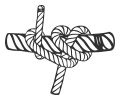Stopperstek
| Stopperstek | |
|---|---|

|
|
| Type | Clamping knot |
| application | Line to hawser |
| Ashley No. | 1734, 1735, 2555 |
| Synonyms | Rollstek |
| English | Rolling hitch |
| List of nodes | |
The Stopperstek is a clamping knot with which a thinner line is connected to a thicker rope, hawser or chain. It can also be used when the rope is under tension. It tightens under strain and loosens again when it is relieved and can thus be moved. If there is a lateral load in the direction of the additional trip , it blocks, in the other direction it can be moved.
Names and history
The Stopperstek is particularly common in seafaring . There are two variants, identified in the Ashley Book of Knots , with the numbers 1734, 1735 and 2555. Nodes 1734 and 2555 are identical. These are assigned to the rolling hitches category.
application
With the stopper an auxiliary line can be tied to a tensioned rope in order to relieve this with a winch or a pulley . This is the case, for example, when a sheet is tensioned in the sail by the wind force and jams on the winch (a "defection" forms) or when the rope clamp is blocked in the event of a fall .
On ships that are not equipped with winches , such a working tackle is sometimes necessary in order to trim a sail correctly .
Because the stopper can be moved easily, a load with a winch or a pulley block can be hauled meter by meter with an auxiliary line, for example a heavy weight hanging on a rope, or a heavy or "loosened" anchor chain. In the case of a rope bridge , the suspension rope can be tensioned with it before it is tied to the second anchorage.
The to be towed ship passes a heaving line to a tractor, a thicker line is struck and then pass the towline. A tug always uses its own cables.
effect
The clamping effect is heavily dependent on the difference in rope diameter as well as on the material and surface properties of the two ropes. The knot becomes firm with a difference in diameter from 1 to 1.5 to 1 to 5; but the greater the difference, the weaker the thin line. A good clamping effect is only achieved with a smaller rope diameter with which the knot and the standing rope are tied. Knot no. 1735 is stronger than knot no. 1734, but it is more difficult to move. The more turns are made on the tension side, the higher the clamping effect.
Knot
Variant 1734, 2555
The stopper is basically a loom hook that has two turns on the blocking side (instead of just one as with loom). All three turns have the same direction of rotation.
third turn with slip
The knot can also be tied under tension. Even the first half hit brings a lot of friction and holds some traction. To create more friction, you make a second turn. And so that you don't always have to hold on to the end, you make a third turn around the cable on the other side. The direction of pull must be such that the line is pulled against the first two turns.
The number of turns can be increased if there is a strong pull or if the hawser has a smooth surface.
Variant 1735
Here the variant with the 2 × roll over the pulling part . Stopperstek acc. Sport boat driving license test lake of the DSV
Alternatives
- With vertically directed or hawser low train ranging clove hitch .
- Climbers often use the Prusik knot as a clamping knot .
Modifications
- If you make the third and a further fourth turn in opposite directions of rotation, the Prusik knot is created .
- If the stopper is tied around the same line, the top sail sheet is created and forms an adjustable, non-tightening loop.
Web links
Individual evidence
- ↑ [1] TheAshleyBookOfKnots, page 298 and 411
- ^ Kurt Graf, Dietrich Steinicke: The official sports boat license lake. 17th edition. Delius Klasing, 2012, ISBN 978-3-7688-3486-5 .







